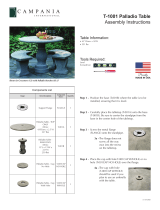Page is loading ...

TheWhiteHouse
WashingtonDCUSA
21006_BI.indd 1
4/13/2010 6:10:02 PM

JamesHoban
James Hoban, 1762-1831, was born in Desart, near Callan,
County Kilkenny, Ireland. Hoban was raised at Cuff esgrange,
Co Kilkenny where he learned carpentry skills. He studied
architecture at the Royal Dublin Society.
During the American Revolutionary War, Hoban
emigrated to the United States, and established himself as
an architect in Philadelphia in 1781. Hoban moved to South
Carolina in 1787, with his brothers Philip and Joseph; he
lived there for at least six more years.
We know little of Hoban’s life in South Carolina
except that he formed a partnership with carpenter
Pierce Purcell and became well known among the
gentry for his ability as an architect and builder. He
was a founding vestryman in 1791 of Saint Mary’s
Church, the fi rst Catholic church established in the
Carolinas. Among Hoban’s references were some
of the most prominent citizens of Charleston: Henry
Laurens, a close friend of President George Washington;
fellow Irishman Aedanus Burke; and American
Revolutionary War General William Moultrie.
The White House Historical Association (White House Collection)
2
21006_BI.indd 2 4/21/2010 1:33:08 PM

Pierre L’Enfant plan of Washington, D.C. WikimediaCommons
Hoban’s name has been connected with public buildings
and plantation houses in the Charleston area, most notably
the historic Charleston County Courthouse and the William
Seabrook house. Another prominent building in Charleston,
actually documented as a Hoban design, was a 1,200-seat
theater on Savage’s Green that no longer survives.
The plan of Washington
In 1791 President George Washington appointed Pierre
Charles L’Enfant to design the new capital city. L’Enfant’s
plan was based on a grid, with streets traveling north-
south and east-west. Diagonal avenues, which came to
be named after the states, crossed the grid, intersecting
with the grid to form plazas. The overall eff ect aimed to
establish a city with direction and character.
To be connected in a straight line by an avenue
160 feet wide, L’Enfant selected two high spots – Jenkins Hill
for the “Congress House” and a second hill a mile and a
half away for the “President’s Palace”. The avenue,
though no longer a straight line since an addition
to the Treasury building in 1840 eff ectively blocked it,
became Pennsylvania Avenue.
3
21006_BI.indd 3
7/2/2010 6:46:24 PM

As described above, the pattern of radiating
avenues was joined and fi lled by a gridiron matrix
of streets, which were numbered to the east
and west and lettered to the north and south –
excluding J Street, which L’Enfant omitted to avoid
confusion with the letters I and J that were indistinguishable
and often interchangeable at the time, according to a
1994 Washington Post Magazine article.
Although L’Enfant’s design became the basis for land
sales, construction and planning, President Washington
fi red him a year after he was hired because L’Enfant
“forged ahead regardless of his orders, the budget, or
landowners with prior claims”.
The design competition
In 1792, at Washington’s request, Secretary of State Thomas
Jeff erson announced an architectural competition to
produce design drawings for the President’s House.
Washington insisted that the building should be made of
stone, so that it would have a more substantial appearance,
much like the most important buildings in Europe. The
young nation had never seen anything like it, and that was
what Washington liked about it. The building was to be
more than the home and offi ce of the president; it was to
be a symbol of the presidency. A republic could not have
a king’s palace, but the building must command respect
from citizens in the United States and, just as importantly,
foreign visitors who came to visit America’s leader.
On July 16, 1792, President Washington examined
at least six designs submitted in the President’s House
architectural competition. The plans were quite varied.
One of the designs was by James Hoban, an Irishman
whom the president had met a year earlier in Charleston. A
second plan was submitted by a mysterious man known
only as “A.Z.”. Historians have speculated that Thomas
Jeff erson was the mystery designer, but records suggest
that the architect in question was more likely John Collins,
a builder from Richmond, Virginia. A third of the six
designs is by James Dimond, a Maryland inventor.
4
21006_BI.indd 4
7/2/2010 6:46:25 PM

President Washington sought out Hoban, conferred with
him, and quickly selected the architect’s proposed de-
sign for the President’s House in July 1792.
Thomas Jeff erson, himself of Irish descent, must
have gained particular pleasure as the second occupant
of the White House in Washington, which was doubtless
inspired by Irish Palladianism. Both Castle Coole and
Leinster House in Dublin claim to have inspired James Hoban.
The Palladianism of the White House is interesting as it
is almost an early form of neoclassicism, especially the
South facade, which closely resembles James Wyatt’s
design for Castle Coole of 1790, also in Ireland. Ironically,
the North facade lacks one of the fl oors from Leinster
House, while the Southern facade is given one fl oor more
than Castle Coole, and has an external staircase more in
the Palladian manner.
Time, and occupants, have altered the White
House in many ways. However, the White House image
is Hoban’s entirely. It is a handsome residence,
embellished with unquestionably the fi nest architectural
stone carving produced in America at that time. And when
Hoban rebuilt it, following the fi re in 1814, he was ordered
to make it as it had been, which he did, perpetuating the
image and his own claim to a place in history.
Hoban died on December 8, 1831. He is buried at
Mount Olivet Cemetery in Washington, D.C.
JamesHoban’sWhiteHousedesign
WikimediaCommons
5
21006_BI.indd 5
7/2/2010 6:46:26 PM

HistoryofTheWhiteHouse
TheWhiteHousehasatotalofsixstoreysatwo-storey
basementtheGroundFloorStateFloorSecondFloor
andThirdFloorThereareroomsbathroomsand
levels in the White House There are alsodoors
windowsfi replacesstaircasesandelevators
TheWhiteHousehasavarietyofrecreationfacilities
including a tennis court jogging track swimming
poolmovietheaterbilliardroomandabowlinglane
The State Floor includes the East Room Green
Room Blue Room Red Room State Dining Room
Family Dining Room Cross Hall Entrance Hall and
Grand Staircase The Ground Floor is made up of the
Diplomatic Reception Room Map Room China Room
Vermeil Room Library the main kitchen and other
offi cesThesecondfl oorfamilyresidenceincludesthe
YellowOvalRoomEastandWestSittingHallstheWhite
House Master Bedroom President’s Dining Room the
Treaty Room Lincoln Bedroom and Queens’ Bedroom
as well as two additional bedrooms a smaller kitchen
andaprivatedressingroomThethirdfl oorconsistsof
theWhiteHouseSolariumGameRoomLinenRooma
DietKitchenandanothersittingroom
TheexterioroftheWhiteHousewasexpandedto
include two colonnades in Further additions
includetheSouthporticoinandtheNorthportico
in Today the porticos connect to the East and
WestWingsTheWestWingwasaddedtothehousein
withtheOvalOffi ceaddedtothewinginThe
EastWingwasaddedin
Lorenzo Winslow’s 1948 plan for
changes. White House Museum
Alterations to the Executive Mansion.
Library of Congress, Prints & Photo-
graphs Division
6
21006_BI.indd 6
7/2/2010 6:46:26 PM

TheWhiteHouseisagrandmansionintheneoclassical
Federal style with details that echo classical Greek
Ionic architecture James Hoban’s original design was
modeledaftertheLeinsterHouseinDublinIrelandand
didnotincludethenorthandsouthporticos
Federal-style architecture is the name for the
classicizing architecture built in the United States
between c. 1780 and 1830, and particularly from 1785 to
1815. This style shares its name with its era, the Federal
Period. In the early Republic, the founding generation
consciously chose to associate the nation with the
ancient democracies of Greece and the republican
values of Rome. Grecian aspirations informed the Greek
Revival, lasting into the 1850s. Using Roman architectural
vocabulary, the Federal style applied to the balanced
and symmetrical version of Georgian architecture that
had been practiced in the American colonies new motifs
of neoclassical architecture as it was epitomized in
Britain by Robert Adam, who published his designs in
1792. The classicizing manner of constructions and town
planning undertaken by the federal government was
expressed in federal projects of lighthouses and harbor
buildings, hospitals and in the rationalizing urbanistic
layout of L’Enfant’s Washington, D.C. and in New York the
Commissioners’ Plan of 1811.
American federal architecture diff ers from preceding
Georgian colonial interpretations in its use of plainer
surfaces with attenuated detail, usually isolated in panels,
tablets and friezes.
Federalstyle
Sailors’ Snug Harbor, Minard Lafever.
WikimediaCommons
Tennessee State Capitol, William
Strickland. WikimediaCommons
7
21006_BI.indd 7
7/2/2010 6:46:27 PM

FactsfromTheWhiteHouse
Location ..........................PennsylvaniaAvenue
WashingtonDCUSA
Style ..................................NeoclassicalFederal blended
with Irish Palladianism
Materials .........................AquiaSandstone
Size ....................................ft
m
Year ....................................FirstcornerstonelaidinOctober
ofThefullconstructionof
thebuildingtookplacebetween
andwhenthefi rst
residentsmovedin
8
21006_BI.indd 8
4/13/2010 6:10:07 PM

1x
1
1x
9
21006_BI.indd 9
4/13/2010 6:10:08 PM

2
2x 3x
10
21006_BI.indd 10
4/13/2010 6:10:09 PM

4x
4
x
2x
3
1x
11
21006_BI.indd 11
4/13/2010 6:10:10 PM

2x
4
12
21006_BI.indd 12
4/13/2010 6:10:11 PM

2x2x
5
2x
x
13
21006_BI.indd 13
4/13/2010 6:10:12 PM

4x
6
14
21006_BI.indd 14
4/13/2010 6:10:14 PM

2x
7
15
21006_BI.indd 15
4/13/2010 6:10:16 PM

2x 6x 1x
8
1x
16
21006_BI.indd 16
4/13/2010 6:10:17 PM

2x 1x 1x 2x
9
17
21006_BI.indd 17
4/13/2010 6:10:19 PM

2x 2x 4x
10
18
21006_BI.indd 18
4/13/2010 6:10:21 PM

The front and rear porticos were added
to the White House in and
respectively when Thomas Jeff erson
commissioned Benjamin Henry Latrobe
to make architectural changes to the
mansionLatrobehaddrawnupproposals
thatincludedporticosasearlyas
The front and rear
p
orticos were added
to t
h
e W
h
ite Ho
us
e in an
d
respectively when Thomas Jeff
erson
ff
ff
commissione
d
Ben
j
amin Henry Latro
b
e
to ma
k
e arc
h
itectura
l
c
h
anges to t
h
e
mansion
Latrobehaddrawnupproposals
tha
ti
ncluded p
ort
ico
sa
se
arl
ya
s
2x 2x
6x
1x
11
19
21006_BI.indd 19
7/2/2010 6:46:28 PM

2x2x
2x
1x 2x
12
20
21006_BI.indd 20
4/13/2010 6:10:28 PM
/

